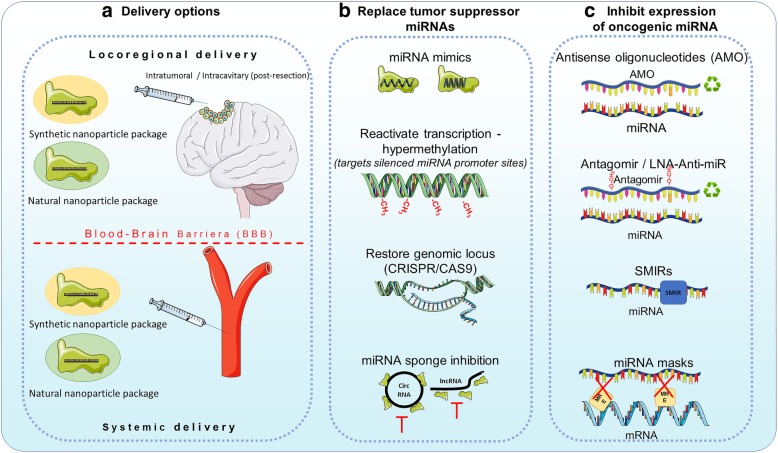Fig. 1.
MiRNA therapy for glioblastoma. MiRNA therapy can be classified into miRNA restoration therapy (i.e. restoring tumor suppressor miRNAs) and miRNA inhibition therapy (inhibiting oncomiRs). a The delivery of this potential therapy is hindered by the selective structure of the blood brain barrier (BBB). We can envision two possible delivery methods – locoregional (post-surgery) and systemic. Locoregional is invasive but the BBB is directly by-passed, the systemic delivery on the other hand is less invasive and can be repeated multiple times. The most suitable carriers of this therapy are nanoparticles, which can be synthetic or natural, by offering the advantage of a higher half-time for the therapeutic agent, at a lower dose and with fewer side effects. b The methods to achieve miRNA restoration therapies can be direct: delivery of miRNA mimics – single/double strand synthetic RNA molecules that mimic the function of endogenous miRNAs or indirect: reactivation of transcription by using hypomethilating drugs (Decitabine or 5-azacytidine); restoring the genomic locus of a miRNA using Crispr/CAS9 or vectors expressing the missing miRNA or inhibiting ceRNA molecules that sponge anti-tumorigenic miRNAs. c The inhibition of oncomiRs can be realized by AMOs (antisense oligonucleotides) that covalently bind mature miRNAs and induce their degradation; antagomirs or LNA anti-miRs which are chemically modified antisense RNA molecules, that have a higher stability and a lower degradation level compared to AMOs; small molecule miRNA inhibitors (SMIRs) which block the function of specific miRNAs by structure-based binding to the precursor or mature form of miRNA; and miRNA masks which block the miRNA response elements (MREs) on mRNAs so that miRNAs cannot achieve their inhibitory function

